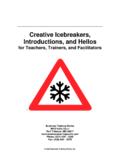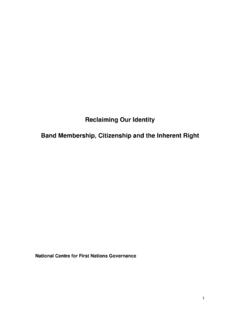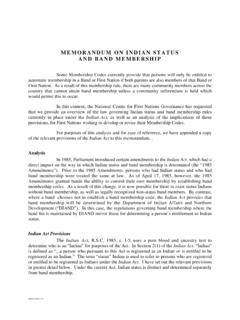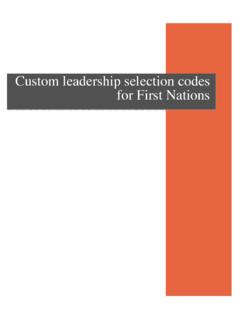Transcription of NCNFG | Indian Act Colonialism: A Century Of Dishonour ...
1 John MilloyIndian Act colonialism : ACentury Of Dishonour , 1869-1969 research Paper for theNational Centre for First Nations GovernanceMay, 2008 Indian ACT colonialism : A Century OF Dishonour , 1869-1969 Introduction: colonialism - Canada s National 1867, with the passage of the British North America Act, Canadiansbegan the process of nation building. Over the next few years, newprovinces emerged Manitoba, British Columbia, Prince Edward Island and Canada became, by 1873, a nation from sea to sea. At the same time, byway of three legal instruments, the federal government was equipped tofunction as an imperial power. Section 91:24 of the Act assigned to itthe responsibility for all indians and lands reserved for indians aresponsibility that had been carried by the Imperial government for theprevious Century .
2 The Rupert s Land Order in Council transferred the vastHudson s Bay territories to Canada s exclusive jurisdiction. And finally, inthe Indian Act of 1869, the government set out its own vision of futureCanada-First Nations relations: an aggressive colonizing project ofassimilation not only of First Nations in those territories but of all FirstNations throughout the nation. Successive federal governments, Liberal andConservative, over the next Century , in amendments to the 1869 Act and innew Acts, spelled out, in increasing detail, a colonial structure that passedcontrol of First Nations people and communities into the hands of the IndianAffairs Department. That structure survived without effective opposition orchange until s colonization of First Nations was not a wholly new initiative in1869; it rested, in part, on an Imperial policy heritage.
3 Thus while the firstIndian Act departed significantly from some elements of past British policy,it maintained others. The foundation of British policy was the historicProclamation of 1763. The principles it laid down with respect to land andits inherent respect for the national character of First Nations formed thecore of British- Indian relations and re-emerged in the late 1970s as thebaseline of Canadian-First Nations relations. Certainly, the fundamentalcharacteristics of the contemporary relationship emanate from it: therecognition of Aboriginal rights, the Canadian treaty system and, of course,the persistent court cases geared to clarifying the nature of the existingrights embedded in the repatriated Constitution of 1982 - a constitutionwhich specifically recognizes the continuing existence and significance ofthe Proclamation and its , the centrality given to the Proclamation in the 1982 Constitution,and its respect for Aboriginal rights, is only a relatively recent feature ofCanada s history.
4 For most of that history, from 1869 forward, theProclamation s principles were alternately ignored, violated or, more oftenthan not, applied with an eye to serving first national and only incidentallyAboriginal best interests. In the Proclamation s place, the relationshipbetween Canada and First Nations was shaped by other influences, more by cultural forces rather than legal principles. Those forceful determinantswere private property ownership and the rhetoric of Empire - the whiteman s burden. Together, they were the primary markers of 18th and19th Century British civilization; and in Canada, they were the formativeelements of federal Indian policy - a policy with a fixed, unwavering goal, aCanadian version of the burden. As Canada s first Prime Minister, , informed Parliament, it was the nation s duty to do away withthe tribal system and assimilate the Indian peoples in all respects to theinhabitants of the Dominion.
5 IilAssimilation became the enduring justification for federal colonialism . Tothat end, Macdonald s, and governments that followed, marginalized muchof the Proclamation. Most critically, indians who had been allies, or, in thewords of the Proclamation, Nations or Tribes of indians with whom We areconnected, iii were, by the Indian Acts, extensively colonized and made theobjects of penetrating federal control; First Nation s self-government wasended. Not until the failure of the Trudeau/Chr tien White Paper proposal inthe early 1970s was the determination to assimilate the Indian peoples ivabandoned and a search begun in constitutional conferences and court roomsto a find a place in Confederation for First Nations that would fully respecttheir existing rights.
6 Laying the Foundations of Canadian colonialism : The Proclamation of 1763At Canada s birth, the federal government inherited the Proclamation s basicprinciples. Adopted in 1763, the Proclamation had set out a three-cornedsystem of governance for British North America, combining the ImperialCrown, its colonies and those Nations or Tribes of indians . This system,with only slight amendments, became Canada s constitutional structure in1867. The Imperial Crown gave way to the Federal, the colonies becameprovinces and the self-governing First Nations remained, for a brief period, athird order of cornerstone of that order was the recognition of Indian land tenurewithin an over-arching Crown sovereignty; the recognition, in fact, of anAboriginal right to land, that would be, thereafter, alienable only to theCrown by purchase.
7 This facet of the Proclamation, the Canadiangovernment maintained. After Confederation, negotiated purchases, treatiesbased on Proclamation procedures, prefaced the creation of provinces in theprairies and national expansion into the north. Only in the case of BritishColumbia s entrance into the federation in 1871 was this Canada system abandoned in the face of the argument by the province that treaties were notnecessary for the pacification of First back from treaty history at that point and scanning the next onehundred years of treaty-making reveals some underlying nationwidecommonalities. A pattern was set; national tribal homelands, reserves, wererecognized and their boundaries marked out. For these, the Crown had theduty to provide, in the words of the Proclamation, Protection so that tribalnations should not be molested or disturbed vi in their enjoyment and use oftheir land.
8 This created a Crown-First Nations relationship, a fiduciaryrelationship, that would remain a basic element of Canadian the treaties set out the geographic boundaries separating colony fromFirst Nation, the second significant principle of the Proclamation dealt withconstitutional relations amongst the three elements of the Proclamation sgovernance system. Again the issue of land was the starting point. Colonieswere forbidden from purchasing Indian landvii and were not permitted any legislative interference viii in Indian affairs. For its part, the Imperialgovernment undertook to deal with the tribes as if they were indisputablyindependent political entities, nations with Possessions, Rights andPrivileges to be respected ix including recognition of the ancient Rules andConstitutions by which they are governed.
9 X Years later, in 1836, the UpperCanadian Attorney General, R. Jamieson, gave evidence of the continuationof that constitutional norm. First Nations, he wrote have within their owncommunities governed themselves by their own laws and customs. xi Inshort, First Nations were self-governing within their recognized jurisdictionsincluding all internal affairs. They remained so until the Indian Act of Confederation, only some of these constitutional forms weremaintained. The responsibility for conducting relations with First Nationswas shifted from the Imperial to the Federal government; the Imperial IndianDepartment became the Canadian Indian Department. And as had been thecase with colonial governments, their Canadian provincial successors weregiven neither authority over, nor any responsibility to, Indian peoples,communities or land.
10 First Nations were an exclusive Federal responsibility or so it was assumed generally until the issue was complicated in the late1940s by Canadian citizenship legislation, Indian urbanization andamendments to the Indian Act in every important element of the Proclamation s governance system wascarried forward, however, into the post-Confederation period. Most notably,First Nations self-government, was sacrificed to Macdonald s proclaimedassimilative duty. This radical colonizing gesture was not in any way a legalor constitutional requirement of the transfer of the responsibility for IndianAffairs from the Imperial to the Federal government. Rather the root causeof that dramatic shift lay in the consequences of an Imperial social policy forFirst Nations that had been developed in the final three decades beforeConfederation - a policy of civilizationThe Move from Civilization to AssimilationIn 1830, the Colonial Office in London adopted the settled purpose ofgradually reclaiming them [the tribes] from a state of barbarism and ofintroducing amongst them the industrious and peaceful habits of life.







